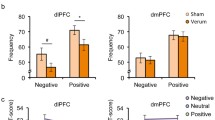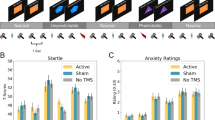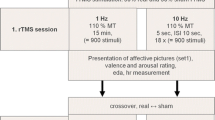Abstract
Repetitive transcranial magnetic stimulation (rTMS) enables the local and non-invasive modulation of cortical activity and has proved to achieve antidepressant effects. To a lesser extent, rTMS is investigated as a treatment option for anxiety disorders. As the prefrontal cortex and the amygdala represent key components of human emotion regulation, we investigated how prefrontally applied rTMS affects the responsiveness of the subcortical amygdala during a fear-relevant study paradigm to examine potential cortico-limbic effects. Sham-controlled, randomised inhibitory rTMS (continuous theta burst stimulation, TBS) was applied to 102 healthy subjects (female = 54) over the right dorsolateral prefrontal cortex. Subsequently, the emotion-potentiated (unpleasant, neutral, and pleasant International Affective Picture System pictures) acoustic startle response was investigated. Subjective anxiety ratings (anxiety sensitivity, trait and state anxiety) were considered. Picture category affected the startle magnitude as expected for both TBS intervention groups (highest startle response for unpleasant, lowest for pleasant pictures). However, no modulatory effects of TBS on startle potentiation were discerned. No significant interaction effects of TBS intervention, subjective anxiety ratings, and gender were identified. Interestingly, startle habituation was influenced by TBS intervention on a trend-level, with verum TBS leading to an accelerated habituation. We found no evidence for the hypothesis that prefrontal inhibitory TBS affects the responsiveness of the amygdala during the presentation of emotionally relevant stimuli in healthy subjects. Instead, we found accelerated habituation under verum TBS on a statistical trend-level. Hence, some preliminary hints for modulatory effects of inhibitory TBS on basic learning mechanisms could be found.


Similar content being viewed by others
References
Andrews SE, Blumenthal TD, Flaten MA (1998) Effects of caffeine and caffeine-associated stimuli on the human startle eyeblink reflex. Pharmacol Biochem Behav 59:39–44
Baeken C, De Raedt R, Van Schuerbeek P et al (2010) Right prefrontal HF-rTMS attenuates right amygdala processing of negatively valenced emotional stimuli in healthy females. Behav Brain Res 214:450–455. doi:10.1016/j.bbr.2010.06.029
Beck AT, Brown GK, Steer RA (2013) Beck-Depressions-Inventar-FS (BDI-FS). Manual. Deutsche Bearbeitung von Sören Kliem & Elmar Brähler. Pearson, Frankfurt am Main
Berg K, Balaban MT (2008) Startle elicitation: stimulus parameters, recording techniques, and quantification. In: Dawson ME, Schell AM, Bohmelt AH (eds) Startle modification implications for neuroscience, cognitive science, and clinical science, 2nd edn. Cambridge University Press, Cambridge, pp 21–50
Berlim MT, Van den Eynde F, Daskalakis ZJ (2013) High-frequency repetitive transcranial magnetic stimulation accelerates and enhances the clinical response to antidepressants in major depression: a meta-analysis of randomized, double-blind, and sham-controlled trials. J Clin Psychiatry 74:e122–e129. doi:10.4088/JCP.12r07996
Bianchin M, Angrilli A (2012) Gender differences in emotional responses: a psychophysiological study. Physiol Behav 105:925–932. doi:10.1016/j.physbeh.2011.10.031
Blumenthal TD, Cuthbert BN, Filion DL et al (2005) Committee report: Guidelines for human startle eyeblink electromyographic studies. Psychophysiology 42:1–15. doi:10.1111/j.1469-8986.2005.00271.x
Bradley MM, Cuthbert BN, Lang PJ (2008) Affect and the startle reflex. In: Dawson ME, Schell AM, Bohmelt AH (eds) Startle modification implications for neuroscience, cognitive science, and clinical science, 2nd edn. Cambridge University Press, Cambridge, pp 157–186
Charney DS (2003) Neuroanatomical circuits modulating fear and anxiety behaviors. Acta Psychiatr Scand Suppl 108:38–50
Cho SS, Ko JH, Pellecchia G et al (2010) Continuous theta burst stimulation of right dorsolateral prefrontal cortex induces changes in impulsivity level. Brain Stimul 3:170–176. doi:10.1016/j.brs.2009.10.002
Couturier JL (2005) Efficacy of rapid-rate repetitive transcranial magnetic stimulation in the treatment of depression: a systematic review and meta-analysis. J Psychiatry Neurosci 30:83–90
Davidson RJ (1998) Affective style and affective disorders: perspectives from affective neuroscience. Cogn Emot 12:307–331
Davidson RJ (2002) Anxiety and affective style: role of prefrontal cortex and amygdala. Biol Psychiatry 51:68–80
Davis M, Falls W, Campeau S, Kim M (1993) Fear-potentiated startle: a neural and pharmacological analysis. Behav Brain Res 58:175–198
Dawson ME, Schell AM, Bohmelt AH (2008) Startle modification implications for neuroscience, cognitive science, and clinical science, 2nd edn. Cambridge University Press, Cambridge
De Raedt R, Leyman L, Baeken C et al (2010) Neurocognitive effects of HF-rTMS over the dorsolateral prefrontal cortex on the attentional processing of emotional information in healthy women: an event-related fMRI study. Biol Psychol 85:487–495. doi:10.1016/j.biopsycho.2010.09.015
Domschke K, Gajewska A, Winter B et al (2012a) ADORA2A Gene variation, caffeine, and emotional processing: a multi-level interaction on startle reflex. Neuropsychopharmacology 37:759–769. doi:10.1038/npp.2011.253
Domschke K, Klauke B, Winter B et al (2012b) Modification of caffeine effects on the affect-modulated startle by neuropeptide S receptor gene variation. Psychopharmacology 222:533–541
Domschke K, Winter B, Gajewska A et al (2015) Multilevel impact of the dopamine system on the emotion-potentiated startle reflex. Psychopharmacology 232:1983–1993
Downar J, Daskalakis ZJ (2013) New targets for rTMS in depression: a review of convergent evidence. Brain Stimul 6:231–240. doi:10.1016/j.brs.2012.08.006
Duncan E, Madonick S, Chakravorty S et al (2001) Effects of smoking on acoustic startle and prepulse inhibition in humans. Psychopharmacology 156:266–272
Etkin A, Wager T (2007) Functional neuroimaging of anxiety: a meta-analysis of emotional processing in PTSD, Social anxiety disorder, and specific phobia. Am J Psychiatry 164:1476–1488
Gamboa OL, Antal A, Moliadze V, Paulus W (2010) Simply longer is not better: reversal of theta burst after-effect with prolonged stimulation. Exp Brain Res 204:181–187. doi:10.1007/s00221-010-2293-4
Garcia-Toro M, Salva J, Daumal J et al (2006) High (20-Hz) and low (1-Hz) frequency transcranial magnetic stimulation as adjuvant treatment in medication-resistant depression. Psychiatry Res 146:53–57. doi:10.1016/j.pscychresns.2004.08.005
George MS, Taylor JJ, Short EB (2013) The expanding evidence base for rTMS treatment of depression. Curr Opin Psychiatry 26:13–18. doi:10.1097/YCO.0b013e32835ab46d
Ghashghaei HT, Hilgetag CC, Barbas H (2007) Sequence of information processing for emotions based on the anatomic dialogue between prefrontal cortex and amygdala. Neuroimage 34:905–923. doi:10.1016/j.neuroimage.2006.09.046
Grillon C (2008) Models and mechanisms of anxiety: evidence from startle studies. Psychopharmacology 199:421–437. doi:10.1007/s00213-007-1019-1
Grillon C, Baas J (2003) A review of the modulation of the startle reflex by affective states and its application in psychiatry. Clin Neurophysiol 114:1557–1579. doi:10.1016/S1388-2457(03)00202-5
Grillon C, Davis M (1995) Acoustic startle and anticipatory anxiety in humans: effects of monaural right and left ear stimulation. Psychophysiology 32:155–161
Hariri AR, Bookheimer SY, Mazziotta JC (2000) Modulating emotional responses: effects of a neocortical network on the limbic system. Neuroreport 11:43–48
Hariri AR, Mattay VS, Tessitore A et al (2003) Neocortical Modulation of the amygdala response to fearful stimuli. Biol Psychiatry 53:494–501. doi:10.1016/S0002-3223(03)01786-9
Hautzinger M, Bailer M, Worall H, Keller F (1995) Beck-Depressions-Inventar (BDI). Testhandbuch, 2nd edn. Huber, Bern
Herwig U, Satrapi P, Schönfeldt-Lecuona C (2003) Using the international 10-20 EEG system for positioning of transcranial magnetic stimulation. Brain Topogr 16:95–99
Huang Y-Z, Edwards MJ, Rounis E et al (2005) Theta burst stimulation of the human motor cortex. Neuron 45:201–206. doi:10.1016/j.neuron.2004.12.033
Hubbard CS, Ornitz E, Gaspar JX et al (2011) Modulation of nociceptive and acoustic startle responses to an unpredictable threat in men and women. Pain 152:1632–1640. doi:10.1016/j.pain.2011.03.001
Jasper H (1958) The ten-twenty electrode system of the International Federation. Electroencephalogr Clin Neurophysiol 10:371–375
Jung NH, Delvendahl I, Kuhnke NG et al (2010) Navigated transcranial magnetic stimulation does not decrease the variability of motor-evoked potentials. Brain Stimul 3:87–94. doi:10.1016/j.brs.2009.10.003
Kemper CJ, Ziegler M, Taylor S (2009) Überprüfung der psychometrischen Qualität der deutschen Version des Angstsensitivitätsindex-3. Diagnostica 55:223–233. doi:10.1026/0012-1924.55.4.223
Kim MJ, Whalen PJ (2009) The structural integrity of an amygdala-prefrontal pathway predicts trait anxiety. J Neurosci 29:11614–11618. doi:10.1523/JNEUROSCI.2335-09.2009
Klauke B, Winter B, Gajewska A et al (2012) Affect-modulated startle: interactive influence of catechol-O-methyltransferase Val158Met genotype and childhood trauma. PLoS One 7:e39709
Lang PJ (1980) Behavioral treatment and bio-behavioral assessment: computer applications. In: Sidowski JB, Johnson JH, Williams TA (eds) Technology in Mental Health Care Delivery Systems Ablex, Norwood, pp 119–137
Lang PJ, Bradley MM, Cuthbert BN (2005) International affective picture system (IAPS): affective ratings of pictures and instruction manual. Technical Report A-6. University of Florida, Gainesville
Laux L, Glanzmann P, Schaffner P, Spielberger CD (1981) STAI: State-Trait-Angstinventar. Beltz Test GmbH, Göttingen
Lisanby SH, Belmaker RH (2000) Animal models of the mechanisms of action of repetitive transcranial magnetic stimulation (RTMS): comparisons with electroconvulsive shock (ECS). Depress Anxiety 12:178–187. doi:10.1002/1520-6394(2000)12:3<178:AID-DA10>3.0.CO;2-N
Machado S, Paes F, Velasques B et al (2012) Is rTMS an effective therapeutic strategy that can be used to treat anxiety disorders? Neuropharmacology 62:125–134. doi:10.1016/j.neuropharm.2011.07.024
Martin JL, Barbanoj MJ, Schlaepfer TE et al (2002) Transcranial magnetic stimulation for treating depression. Cochrane database Syst Rev. doi:10.1002/14651858.CD003493
McTeague LM, Lang PJ (2012) The anxiety spectrum and the reflex physiology of defense: from circumscribed fear to broad distress. Depress Anxiety 29:264–281. doi:10.1002/da.21891
Miller MW, Gronfier C (2006) Diurnal variation of the startle reflex in relation to HPA-axis activity in humans. Psychophysiology 43:297–301. doi:10.1111/j.1469-8986.2006.00400.x
Mineka S, Cannon T (1999) Mechanisms of change in exposure therapy for anxiety disorders. In: Dalgleish T, Power MJ (eds) Handbook of cognition and emotion. Wiley, New York, pp 747–764
Mitchell DGV (2011) The nexus between decision making and emotion regulation: a review of convergent neurocognitive substrates. Behav Brain Res 217:215–231. doi:10.1016/j.bbr.2010.10.030
Mühlberger A, Wieser MJ, Pauli P (2008) Darkness-enhanced startle responses in ecologically valid environments: a virtual tunnel driving experiment. Biol Psychol 77:47–52
Nitschke JB, Heller W (2005) Distinguishing neural substrates of heterogeneity among anxiety disorders. Int Rev Neurobiol 67:1–42. doi:10.1016/S0074-7742(05)67001-8
Nyffeler T, Wurtz P, Lüscher H-R et al (2006) Extending lifetime of plastic changes in the human brain. Eur J Neurosci 24:2961–2966. doi:10.1111/j.1460-9568.2006.05154.x
Nyffeler T, Cazzoli D, Hess CW, Müri RM (2009) One session of repeated parietal theta burst stimulation trains induces long-lasting improvement of visual neglect. Stroke 40:2791–2796. doi:10.1161/STROKEAHA.109.552323
Pauli P, Conzelmann A, Mucha RF et al (2010) Affect-modulated startle reflex and dopamine D4 receptor gene variation. Psychophysiology 47:25–33. doi:10.1111/j.1469-8986.2009.00923.x
Perini F, Cattaneo L, Carrasco M, Schwarzbach JV (2012) Occipital transcranial magnetic stimulation has an activity-dependent suppressive effect. J Neurosci 32:12361–12365. doi:10.1523/JNEUROSCI.5864-11.2012
Pridmore S, Fernandes Filho JA, Nahas Z et al (1998) Motor threshold in transcranial magnetic stimulation: a comparison of a neurophysiological method and a visualization of movement method. J ECT 14:25–27
Rossi S, Hallett M, Rossini PM, Pascual-Leone A (2009) Safety, ethical considerations, and application guidelines for the use of transcranial magnetic stimulation in clinical practice and research. Clin Neurophysiol 120:2008–2039. doi:10.1016/j.clinph.2009.08.016
Sheehan DV, Lecrubier Y, Sheehan KH et al (1998) The Mini-International Neuropsychiatric Interview (M.I.N.I.): the development and validation of a structured diagnostic psychiatric interview for DSM-IV and ICD-10. J Clin Psychiatry 59(Suppl 2):22–33 (quiz 34–57)
Silvanto J, Pascual-Leone A (2008) State-dependency of transcranial magnetic stimulation. Brain Topogr 21:1–10. doi:10.1007/s10548-008-0067-0
Spielberger CD (1989) State-trait anxiety inventory: bibliography, 2nd edn. Consulting Psychologists Press, Palo Alto
Suppa A, Huang YZ, Funke K, et al (2016) Ten years of theta burst stimulation in humans: established knowledge, unknowns and prospects. Brain Stimul. doi:10.1016/j.brs.2016.01.006 (in press)
Taylor S, Zvolensky MJ, Cox BJ et al (2007) Robust dimensions of anxiety sensitivity: development and initial validation of the Anxiety Sensitivity Index-3. Psychol Assess 19:176–188. doi:10.1037/1040-3590.19.2.176
Tupak SV, Dresler T, Badewien M et al (2013) Inhibitory transcranial magnetic theta burst stimulation attenuates prefrontal cortex oxygenation. Hum Brain Mapp 34:150–157. doi:10.1002/hbm.21421
Vaidyanathan U, Patrick CJ, Bernat EM (2009) Startle reflex potentiation during aversive picture viewing as an indicator of trait fear. Psychophysiology 46:75–85. doi:10.1111/j.1469-8986.2008.00751.x
Vanderhasselt M-A, Baeken C, Hendricks M, De Raedt R (2011) The effects of high frequency rTMS on negative attentional bias are influenced by baseline state anxiety. Neuropsychologia 49:1824–1830. doi:10.1016/j.neuropsychologia.2011.03.006
Varnava A, Stokes MG, Chambers CD (2011) Reliability of the “observation of movement” method for determining motor threshold using transcranial magnetic stimulation. J Neurosci Methods 201:327–332. doi:10.1016/j.jneumeth.2011.08.016
Wassermann EM, Zimmermann T (2012) Transcranial magnetic brain stimulation: therapeutic promises and scientific gaps. Pharmacol Ther 133:98–107. doi:10.1016/j.pharmthera.2011.09.003
Weigand A, Richtermeier A, Feeser M et al (2013) State-dependent effects of prefrontal repetitive transcranial magnetic stimulation on emotional working memory. Brain Stimul 6:905–912. doi:10.1016/j.brs.2013.06.004
Wiedemann G, Pauli P, Dengler W et al (1999) Frontal brain asymmetry as a biological substrate of emotions in patients with panic disorders. Arch Gen Psychiatry 56:78–84
Zwanzger P, Fallgatter AJ, Zavorotnyy M, Padberg F (2009) Anxiolytic effects of transcranial magnetic stimulation–an alternative treatment option in anxiety disorders? J Neural Transm 116:767–775. doi:10.1007/s00702-008-0162-0
Acknowledgments
This work was supported by the fund “Innovative Medical Research” of the University of Muenster Medical School (Project ZW 211105), and the SFB-TRR58, project C02 (Deutsche Forschungsgemeinschaft, DFG). We acknowledge the support by Ann-Christine Robertz and Fred Rist.
Author information
Authors and Affiliations
Corresponding author
Ethics declarations
Conflict of interest
The authors declare that they have no conflict of interest.
Funding
This work was supported by the fund “Innovative Medical Research” of the University of Muenster Medical School (Project ZW 211105), and the SFB-TRR58, project C02 (Deutsche Forschungsgemeinschaft, DFG).
Ethical approval
All procedures performed in studies involving human participants were in accordance with the ethical standards of the institutional research committee and with the 1964 Helsinki declaration and its later amendments or comparable ethical standards.
Rights and permissions
About this article
Cite this article
Vennewald, N., Winter, B., Limburg, K. et al. Emotional processing and rTMS: does inhibitory theta burst stimulation affect the human startle reflex?. J Neural Transm 123, 1121–1131 (2016). https://doi.org/10.1007/s00702-016-1568-8
Received:
Accepted:
Published:
Issue Date:
DOI: https://doi.org/10.1007/s00702-016-1568-8




